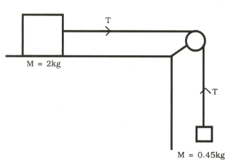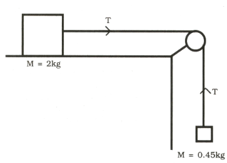A block of metal of mass on a horizontal table is attached to a mass of by a light string passing over a frictionless pulley at the edge of the table.The block is subjected to a horizontal force by allowing the mass to fall. The coefficient of sliding friction between the block and table is . Calculate the tension (in Newton) in the string. ()



Important Questions on Laws of Motion
A block of metal of mass on a horizontal table is attached to a mass of by a light string passing over a frictionless pulley at the edge of the table.The block is subjected to a horizontal force by allowing the mass to fall. The coefficient of sliding friction between the block and table is . Calculate the distance (in metres) the block would continue to move if, after seconds of motion, the string should break. ()

On a smooth horizontal surface a block A of mass is kept. On this block a second block B of mass is kept. The coefficient of friction between the two blocks is . A horizontal force of is applied on the lower block as shown. The force of friction between the blocks is
()

A pebble of mass is thrown vertically upwards. Give the direction and magnitude of the net force on the pebble, during its upward motion. (Ignore air resistance and take )
